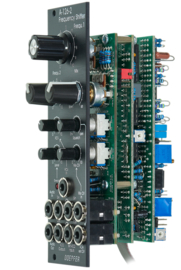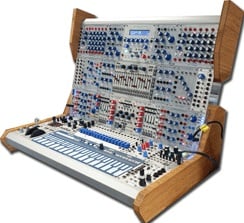Doepfer A-126-2v Voltage Controlled Frequency Shifter II
Doepfer A-126-2v Voltage Controlled Frequency Shifter II (black vintage edition)
(Board A is version 2, with all the in- and outputs)
Module A-126-2 is a fully analog frequency shifter for audio signals. A frequency shifter is an audio processing unit that shifts each frequency of the incoming audio signal by the same frequency. If the shifting frequency is e.g. 200Hz an incoming audio frequency of 1000 Hz becomes 1200 Hz, 2000Hz becomes 2200 Hz, 3000 Hz becomes 3200 Hz and so on. Pay attention that this is different from pitch shifting where all frequencies are shifted proportional (e.g. 1000>1200Hz, 2000>2400Hz, 3000>3600Hz) !
The frequency range of the internal quadrature VCO is about 8 octaves (about 20Hz ... 5kHz). If required an external quadrature VCO can be used.
The module is equipped with these controls, inputs and outputs:
Frequ. 1: first manual control of the shifting frequency (factory setting: coarse, range about 20Hz - 5 kHz)
Frequ. 2: second manual control of the shifting frequency (factory setting: fine)
by means of internal jumpers the sensitivity of Frequ.1 and 2 can be swapped (i.e. Frequ.1 = fine and Frequ.2 = coarse)
the relation between coarse and fine control is about 25:1 (corresponding to about 8 octaves to 1/3 octave)
FCV In (socket) and FCV (small control without knob): control voltage input with attenuator for the external voltage control of the shifting frequency
Mix: manual control of the up/down shift panning unit, fully CCW = down shift, fully CW = up shift, in between a mixture of down and up
Mix CV In (socket) and Mix CV (small control without knob): control voltage input with attenuator for the mixing unit for external voltage control of the up/down mixing
Audio In (socket), Level (small control without knob) and Overload (LED): audio input with attenuator, typ. audio in level = 1Vpp, the level control has to be adjusted so that the overload LED just begins to light up a bit, when the LED is fully on clipping/distortion occurs, when the LED is permanently off the input level is too low and the signal-to-noise ratio increases
Audio Out (socket): audio output of the frequency shifter
Squelch (small control without knob): controls the squelch function: fully CCW (Env.) the output VCA is controlled by the envelope signal, which is derived from the audio input signal, fully CW (open) the output VCA is permanently open (no squelch function), in between the squelch intensity can be adjusted
Quadrature VCO Outputs (sockets Sin and Cos): outputs of the internal quadrature oscillator, about 12Vpp level (+6V/-6V)
Ext. Inputs Sin and Cos (sockets): required when an external quadrature VCO (e.g. A-143-9 with a wider frequency range or A-110-4 with thru zero feature or A-110-6 with different waveforms) is used instead of the internal quadrature VCO, the levels of the external VCO should be about 10Vpp (8...10Vpp are OK) and the signals have to be symmetrical around zero Volts, the sockets are normalled to the internal quadrature VCO (i.e. the sockets are equipped with switching contacts that interrupt the internal connection as soon as a plug inserted)
VCA ext. CV (socket): used when an external control voltage (e.g. from an envelope generator) should be used to control the output VCA instead of the internal squelch unit, the socket is normalled to the output of the squelch control (i.e. the socket is equipped with a switching contact that interrupts the internal squelch connection as soon as a plug inserted). From about +8V external control voltage the VCA is fully open.
Internal terminals (pin headers, e.g. for a DIY breakout module):
envelope follower output
dome filter output 1
dome filter output 2
ring modulator 1 output
ring modulator 2 output
Up shift output
Down shift output
Technical details:
The analog frequency shifter is based on these trigonometric equivalences:
sin(a)*sin(b) = cos(a-b) - cos(a+b)
cos(a)*cos(b) = cos(a-b) + cos(a+b)
Building the sum and difference of these formulas one obtains:
Sum: sin(a)*sin(b) + cos(a)*cos(b) = 2 cos(a-b)
Difference: sin(a)*sin(b) - cos(a)*cos(b) = -2 cos(a+b)
When (a) in these formulas is treated as an audio signal and (b) as a sine signal it's possible to derive an up or down frequency shift with the frequency amount (b) for the audio signal (a). To realize the formulas these electronic circuits are required:
A phase shifter that shifts all frequencies of the audio signal (a) by 90 degrees (sine and cosine are the same signals but with 90 degrees phase difference). Such a circuit can be realized by means of a so-called Dome filter (named after the inventor Robert Dome). The circuit is made in principle with several allpass filters which have to be dimensioned very carefully so that the phase shift for all relevant frequencies is as close as possible to 90 degrees. In the A-126-2 a 12-stage Dome filter is used which is made with close-tolerance parts (resistors with 0.1% tolerance and capacitors with 1% tolerance). That way the time killing adjustment of many trimming potentiometers (with mutual influence) is avoided.
The Dome filter of the A-126-2 generates 90 degrees phase shift with less than 0.3 degrees error over a frequency range of about 50 Hz to 14 kHz.
A quadrature oscillator (i.e. an oscillator with simultaneous sine and cosine output, similar to the already existing modules A-143-9 or A-110-4
two multipliers: in the A-126-2 two ring modulators are used for this job
a summing unit
a subtracting unit
Beyond that the A-126-2 has some special features:
An envelope follower is used to derive an envelope signal from the audio signal. It generates a voltage that corresponds to the current level of the audio signal. A comparator is used to drive an LED which works as overload display. In addition the envelope signal is used to control a VCA which works as a squelch unit.
The up and down outputs are internally connected to the inputs of a voltage controlled crossfader. That way the relation between up and down signal can be controlled manually and by means of an external control voltage.
The module is fully DC coupled so that even very low frequency shifts are possible (with external quadrature VCO)
The sketch in the attached pics shows the internal structure of the module in detail and the phase shift of the dome filter.
Width: 8 HP / 40.3 mm
Depth: 60 mm (measured from the rear side of the front panel)
Current: +80mA (+12V) / -70mA (-12V)








